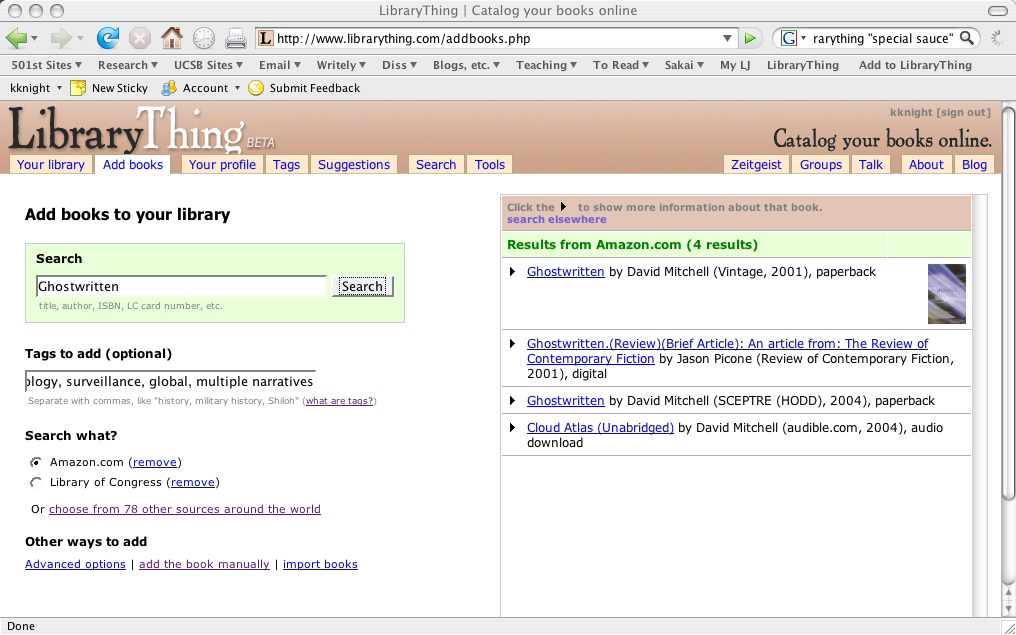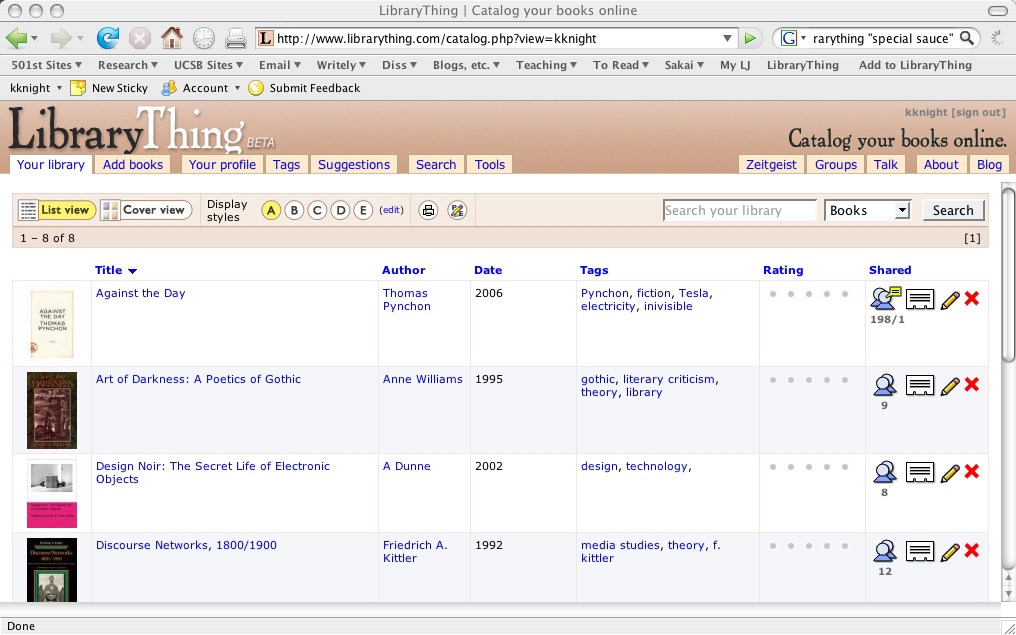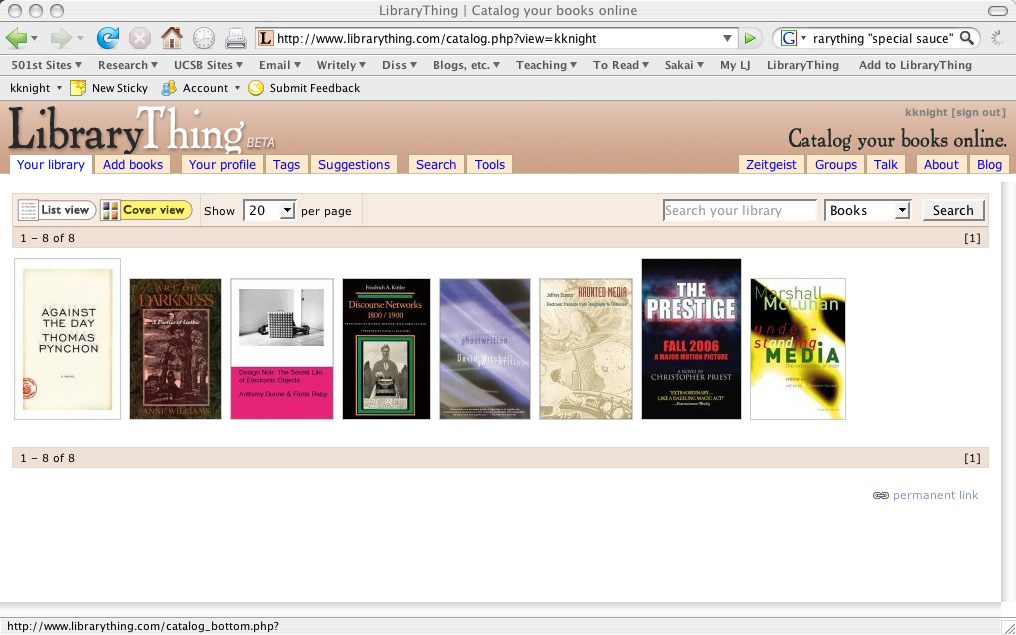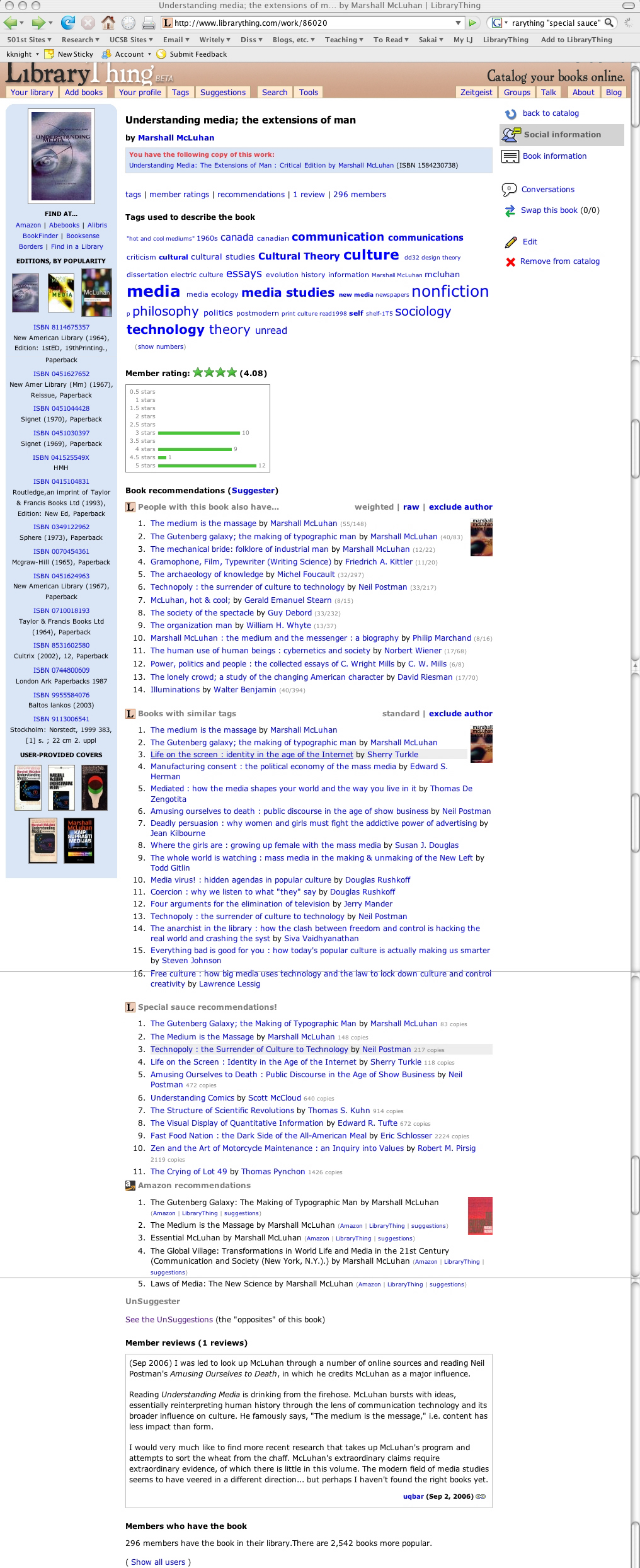Related Categories: Text Visualization | Social Networking Systems | Online Knowledge Bases
Summary:
LibraryThing is an online knowledge base and social networking tool for bibliophiles. The website allows users to catalog their personal libraries. By entering in their own books, users can locate others with similar libraries, find suggestions for books they might like, or even get “unsuggestions” for the books that are least like their own. Users can organize their collections according to self-defined tags and also view how others have tagged the same books.
Description:
Created in 2005 by Tim Spalding, LibraryThing is an online cataloging tool and a social networking site. Currently the “Zeitgeist” page lists 151,179 registered users and 10,552,368 cataloged books.
Users, or “thingamabrarians,” add books to their personal libraries by simply entering the title, ISBN, author, or Library of Congress number into a search box. They have the option to search Amazon.com, The Library of Congress, or up to 78 other libraries worldwide. If a book is not found, users may input books manually, registering the ISBN, Library of Congress, or Dewey reference number.
Once a search is entered, a list of books is returned and the user needs only to select the correct one to add it to his or her library. The user can add tags at the time she is conducting the search, or she may add them later.
Once constructed, the user’s library can be viewed in “list view” and sorted by Title, Date of publication, Author, Tags, Rating, or number of other users who share the book. Alternatively, the library can be viewed in “cover view,” which mimics the look of books on a shelf.
The social networking function of LibraryThing arises when users make their information public. By clicking on the shared information icon, users are taken to a page that presents data based upon the collective cataloging of this particular book:
The shared information page shows all of the other tags that users have applied to this book, average and individual member ratings, book recommendations, unsuggestions, member reviews, and the total number of members who have this particular book. In the book recommendations section, the user is given many different types of recommendations: “people with this book also have…”, “books with similar tags,” “Amazon recommendations,” and “special sauce recommendations,” which are based upon a secret algorithm developed by Tim Spalding. In contrast, the Unsuggester returns a list of books least likely to be in the same library as the user’s. For instance, Marshall McLuhan’s Understanding Media returns an Unsuggester list topped by Ann Brashares’ Sisterhood of the Traveling Pants.
Aside from peering in at others’ collections, there are other ways for users to connect. First, on each user’s profile page, there is a section entitled “Users with your books.” This section shows how many books you share in common with other users. Clicking on a username will take you to that user’s profile, where you can see exactly which books you have in common and you can leave a comment on the other user’s profile.
In addition, LibraryThing hosts a number of discussion groups. Because anyone can start a group, there is a wide variety that reflects the diverse interests of the LibraryThing user community. Groups range from “Roleplayers in Korea” (with 1 member) to “Archaeologists” (16 members) to “Pynchon Pandemonium” (96 members) to “Graduate Students” (413 members). The largest discussion group is “Libarians who LibraryThing” (1739 members). The largest groups are not necessarily the most active, however. The most active group seems to differ from day to day. “What are You Reading Now?” (683 members) and “BookTalk” (4 members) seem to consistently be among the top groups in terms of activity.
Research Context:
Given the number of ways for users to interact with one another, LibraryThing is of interest to those studying online social networking. Additionally, the site may be of interest to the New Reading Interfaces group because of the way it allows users to interface with their books via tag clouds. Individual texts may be read at a distance by viewing the user’s individual or LibraryThing’s collective tags for a book. User libraries may be read the same way, with the potential of uncovering meaning through relationships, overlaps, and dissonance.
Technical Analysis:
LibraryThing is run on five LAMP servers, three of which are used on a daily basis.
According to LibraryThing creator, Tim Spalding, the site utilizes “various open-source libraries, such as PHP Yaz for connecting to
Z39.50 targets” (email communication). Spalding also wrote a MARC-parsing library for LibraryThing.
The LibraryThing staff, which consists of 3 people (Creator Tim Spalding, Librarian Abby Blanchly, and Developer John), uses an internal wiki powered by MediaWiki for administrative purposes.
Evaluation of Opportunities/Limitations for the Transliteracies Topic:
In terms of social networking, there are two possible approaches towards LibraryThing. The first is that given the relatively low level of discussion group activity, the site is not really of interest for Transliteracies. The other possible approach toward LibraryThing views the site as being in its gestational stages and thinks there may be potential in following the site as it evolves (a snapshot of LibraryThing’s recent growth: the site has added 25,000 users and an additional two million books since this report was originally drafted in early January 2007).
As mentioned above, the way that the site allows users to visually interface with their libraries may be of interest to the New Reading Interfaces group. The suggestion and unsuggester function may also be of interest due to the way the machine processes and organizes texts. The six different suggestion lists (based on Amazon.com and LibraryThing data) which all list different suggestions point to the multiplicity of meaning, even when it is entrusted to machinic precision.
Resources for Further Study:
- LibraryThing.
- Rutkoff, Aaron. “Social Networking for Bookworms.”. The Wall Street Journal Online. 27 June, 2006.




